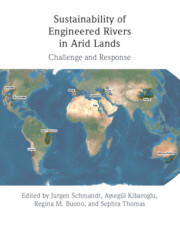Book contents
- Sustainability of Engineered Rivers in Arid Lands
- Sustainability of Engineered Rivers in Arid Lands
- Copyright page
- Dedication
- Contents
- Contributors
- Part I Introduction
- Part II Challenge
- Part III Engineered Rivers
- Part IV Response
- 16 River Basin Management and Irrigation
- 17 “Intelligent” Water Transfers
- 18 Better Basin Management with Stakeholder Participation
- Part V Conclusion
- Index
- References
18 - Better Basin Management with Stakeholder Participation
from Part IV - Response
Published online by Cambridge University Press: 16 September 2021
- Sustainability of Engineered Rivers in Arid Lands
- Sustainability of Engineered Rivers in Arid Lands
- Copyright page
- Dedication
- Contents
- Contributors
- Part I Introduction
- Part II Challenge
- Part III Engineered Rivers
- Part IV Response
- 16 River Basin Management and Irrigation
- 17 “Intelligent” Water Transfers
- 18 Better Basin Management with Stakeholder Participation
- Part V Conclusion
- Index
- References
Summary
This chapter reviews the role of irrigation districts, city water utilities, and environmental groups in basin management. Examples from two river basins – Rio Grande and Euphrates–Tigris – illustrate vast differences in stakeholder participation. The authors recommend that all SERIDAS rivers pay increased attention to this option for better management. The four options for creating sub-basin water councils recommended for the Rio Grande provide useful guidance. Other models, reflecting different basin conditions, may emerge. Whatever model is selected, stakeholders should always organize to address the water agenda of their sub-basin. Doing so directly contributes to reaching and maintaining sustainability of the river as a whole.
Keywords
- Type
- Chapter
- Information
- Sustainability of Engineered Rivers In Arid LandsChallenge and Response, pp. 260 - 270Publisher: Cambridge University PressPrint publication year: 2021
References
- 1
- Cited by



